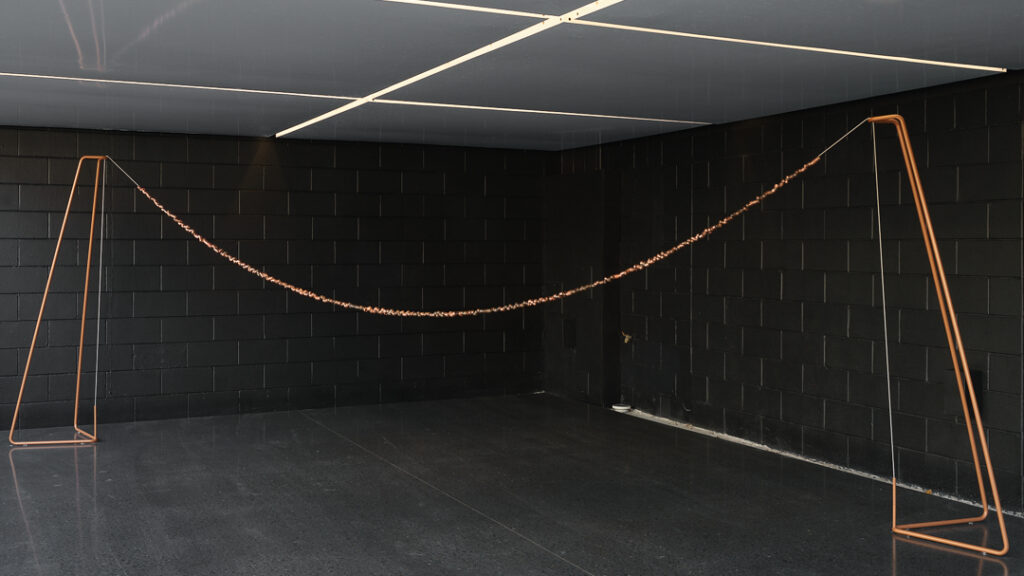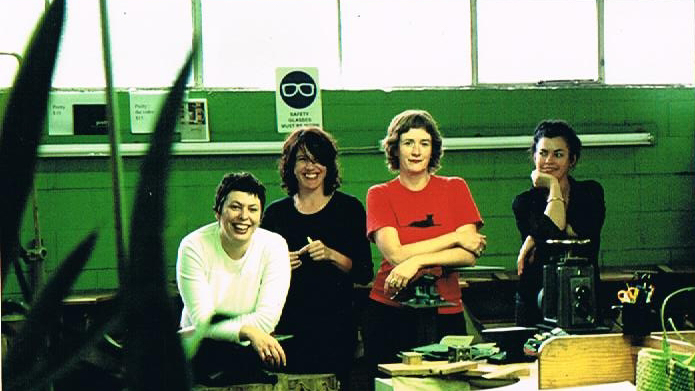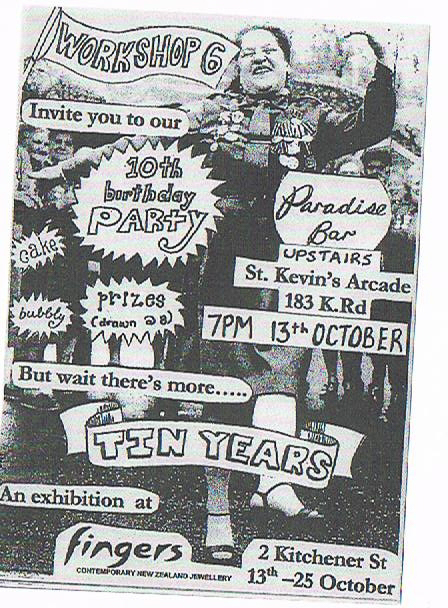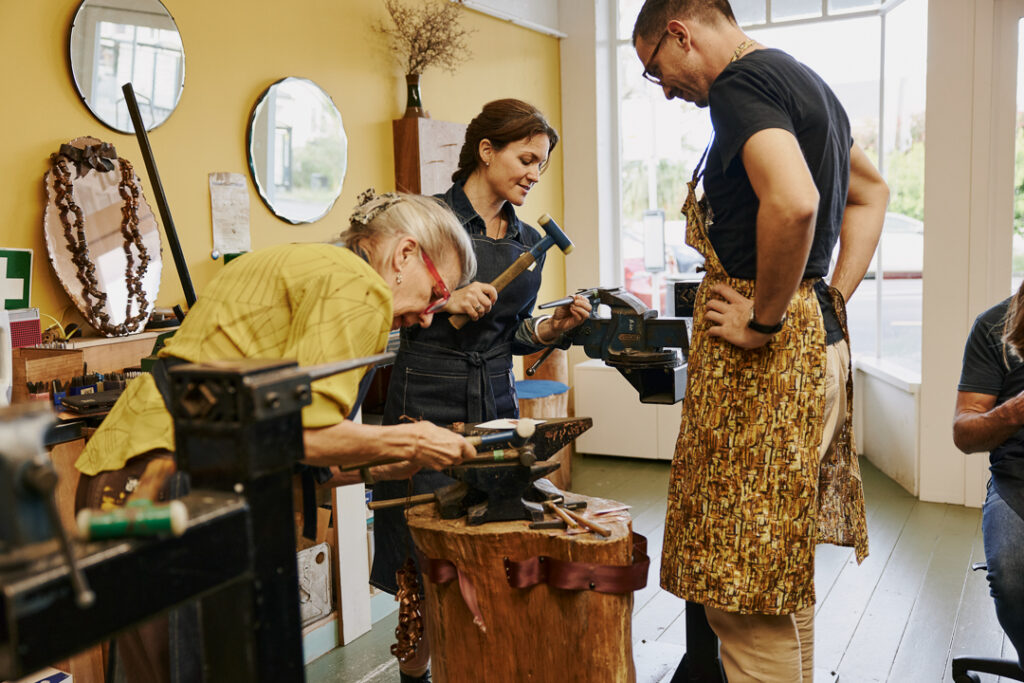Mia Straka recounts the heady journey of a resilient Auckland jewellery collective.
More than 500 copper rings span the dark brick and concrete courtyard. Suspended in a relaxed curve from eye to waist height they invite intimate inspection and tactile interaction. The changeable coastal climate of Tāmaki Makaurau transforms salmon pink copper to rich earth brown, grey and black. Green oxides the colour of new fern fronds appear, and fingerprints from the many ring makers and visitors to the gallery develop like photographs over the course of the year-long installation.
Each individual ring bears the maker’s marks, soft dents of a ball peen hammer, linear tracks, letter stamped initials and personal word plays, cutout patterns and silver solder joints made by the hands of many. Created during special ring-making workshops held at our local Grey Lynn studio, Common Element embodies hundreds of hours of collective making and the sharing of skills at Workshop6. The humble copper ring gains power and presence through multiplicity.
An induction to jewellery making often commences with the crafting of a simple copper ring: a fundamental exercise in metalwork and studio practice. Supported elegantly on a simple display by Michael McCabe and exhibited down the road from the studio at leading design, craft and architecture gallery, Objectspace, Common Element was commissioned as the successful proposal to their 2024 plinth project callout.
History
The project is a fitting way to mark three decades of Workshop6, Aotearoa’s most enduring jewellery collective. Throughout this time, the studio has been a vital hub for metalworking and jewellery craft. Many of Aotearoa’s leading contemporary jewellers have ties to Workshop6; training, teaching and fostering an extensive community through making. The current partnership includes Anna Wallis, Cheryl Sills, Mia Straka and Lucinda Barrett.
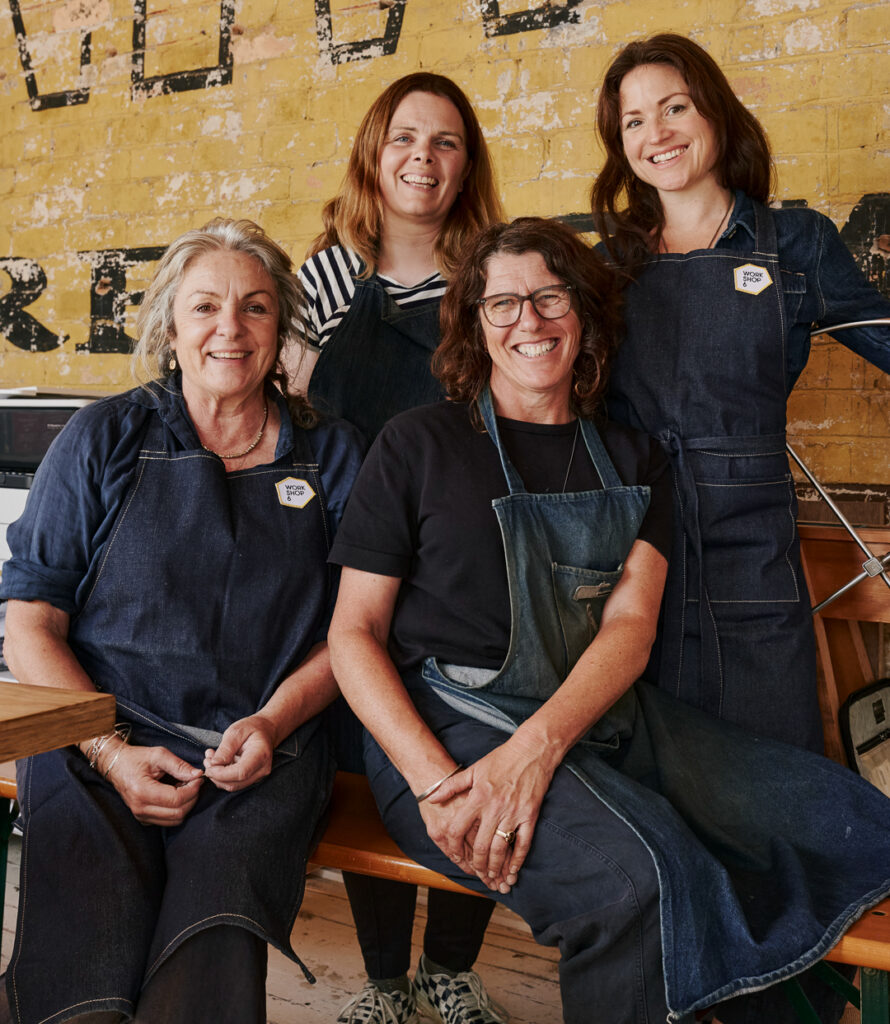
Workshop6 partners 2024 (left-right) Lucinda Barrett, Cheryl Sills, Anna Wallis, Mia Straka, photo: Frances Carter
Established in 1993 by jewellers Anna Wallis, Lisa Walker, Helen O’Connor, and Areta Wilkinson in an old laundry building amongst the colourful villas of Grey Lynn, Workshop6 was a place to share tools and costs, and create a communal jewellery studio. Within a year Workshop6 moved a suburb over to Kingsland, to a basement warehouse studio. A small grant enabled the purchase of hand tools for teaching our craft to the public.
This kicked off the still enduring business model for Workshop6 of teaching jewellery classes to pay the rent, facilitating a collective studio where makers could work on their own practice in a shared space. Workshop6 became a kind of clubhouse for contemporary jewellers. The walls and crevices accrued posters and exhibition flyers, random snippets, jokes and interesting objects.
Classes gained an organic following as a community of makers was born. Some students went on to tertiary study and careers in contemporary jewellery, others continued to return as they gained skills, friendships and a place to make in a supported environment.
Events and milestones
Initially the collective had regular exhibitions in national venues. This gave way to a more individual focus on career paths. From 1995 to 2005 Jane Dodd, Octavia Cook and Jasmine Watson became partners as Lisa Walker, Helen O’Connor and Areta Wilkinson moved away from Auckland. Notable milestones were celebrated with exhibitions and celebrations.
Pretty was a multimedia one-night-only event in Auckland nightclub Herzog in the mid-nineties. An animated video of Workshop6’ers experimental jewellery worn on the body was projected onto a wall of the nightclub. During the night people wearing the jewellery mingled amongst the party guests. The event was documented with a wire-bound booklet including critical discourse, jeweller’s responses to an informal questionnaire, a self-portrait in their favourite place and images of the work. Jane Dodd was memorably photographed adorned in bubbles in her bath at home.
Tin Years marked the 10-year anniversary exhibition at Fingers Gallery with a tin “party” made in miniature, featuring resident jewellers and guests, a cake-laden table set formally with plates and cutlery, streamers, even a champagne puddle; available to purchase singularly or as a set “for the Guggenheim”.
- w6, Tin Years exhibition, Fingers, 2003
- w6 Tin Years flyer 2003
- w6 founding partners (l-r) Areta Wilkinson, Lisa Walker, Helen O’Connor, Anna Wallis
In 2014, Workshop6 came of age, celebrating our 21st year with a move to the iconic Theatre Royal building in Kingsland, built in 1915. The high-ceilinged warehouse lent itself to a big party, complemented by an exhibition at Fingers of past and present Workshop6 jewellers. Work was displayed along a colour-coded timeline across the back wall of Fingers gallery to denote when each jeweller was in residence at Workshop6.
Adaptation
Workshop6 has always been a fluid organisation, adaptable to the changing lives and needs of those involved. As a self-sufficient partnership from our inception in 1994, financial challenges have been weathered with a conservative economic approach and many voluntary hours of administrative tasks behind the scenes.
Decisions are made collectively through conversations around the table. Partnership in Workshop6 has always been made by mutual agreement and with careful consideration that we work well together, like and respect each other, are able to communicate clearly, and have common goals for the workshop environment.
Over the past five years, we have begun to be more business-oriented, increasing our teaching schedule in response to demand and providing a part-time job for each of us, complementary to our self-employed artistic practices as jewellers and makers.
We’ve weathered storms by working as a team and regularly checking in on our mutual goals and values. Just before the pandemic, our Kingsland studio space changed ownership and underwent major renovations, plus an unforeseen roof replacement. The quality of our workspace and activities was compromised, leading to the search and subsequent move to our current premises. Covid-19 hit our shores as we’d finished the fit-out and were ready to re-open, leading to cancelled classes, refunds and reschedules.
The new space is a step up in location, efficiency, comfort and costs. We have managed to navigate these hurdles but times are tight and our buffer has been consumed.
As tertiary-level education in the craft and design sector has been systematically eradicated in Aotearoa over the past decade, Workshop6 is one of the first and almost the last remaining jewellery teaching facilities left in Auckland. We are determined to survive and thrive and are eternally grateful for the strength and support of our community.
Attraction
Each of us has been attracted to Workshop6 as a place to work with like-minded practitioners. We can generate the environment we need to thrive creatively within the collective, as well as to share our skills with others through teaching. This builds community, which gives us all joy and purpose, as well as creating a part-time income to supplement our self-employed income, a necessity in today’s constrictive economic climate.
Plans
To reach a wider audience, we are working with talented designer and friend Tana Mitchell at Studio Akin to build a new website. We aim to create a user-friendly digital interface more representative of our current location and offerings.
We’re also in the process of setting up a regular exhibition schedule in the busy street front window of our studio to exhibit and retail our work, alongside curated student works and guest artists. Situated in a great location within the busy, affluent, city fringe neighbourhood of Grey Lynn, we already have a strong established following over our thirty-plus years of existence as a studio.
Facilitating easier access to information about our offerings and a functional booking system online will help to ensure we continue to flourish in these more challenging times.
Aspirations
We want Workshop6 to be a hub for contemporary jewellers and our community, increasing our offerings to include regular masterclasses, exhibitions and artist residencies.
We hope people continue to increasingly find value and joy in the craft and art of handmade goods, with respect for materials, workwomanship and sustainability.
We work hard to ensure our students love coming to Workshop6, growing in skills and developing creatively alongside building community. It helps to have the freedom to respond to student needs rather than working within a more rigid accredited teaching programme.
We hope creativity will be nurtured within educational frameworks as a way to develop new ways of thinking and being.
We aspire to be a small part of the development of new and adaptable systems to exist, supportive of both individual freedom of mind, body and spirit and communal well-being.
About Mia Straka
I am a Pākeha New Zealander of Bohemian, Dutch and Irish descent living in Tāmaki Makaurau, close to the flat-topped volcanic peak of Puketāpapa – Mount Roskill, Auckland. Since my early 20’s I have been a self-employed contemporary jeweller, supplementing my income by teaching jewellery classes at Collective Workshop6, a jewellery studio I joined in 2008. I’m drawn to making linear 3D forms, building handworked sculptural adornment that has occasionally grown to installation scale. Through my work, I question our prevailing value systems, often incorporating discarded or overlooked materials. Notable projects include The Handshake Project- Handshake6, Handshake7; The Valere Talisman Project (est. 2017) and The Talisman Project (est. 2014). Straka has undertaken art residencies in Berlin, Germany 2018 and Oaxaca, Mexico 2014. Currently, I’m focused on making adornment as an activator, reworking the form of the knuckleduster as a statement of personal power. I’ll be exhibiting at Radiant Pavilion in Melbourne this September with the Handshake6 group at Brunswick Street Gallery. Visit mia-straka.squarespace.com and follow @miastraka

